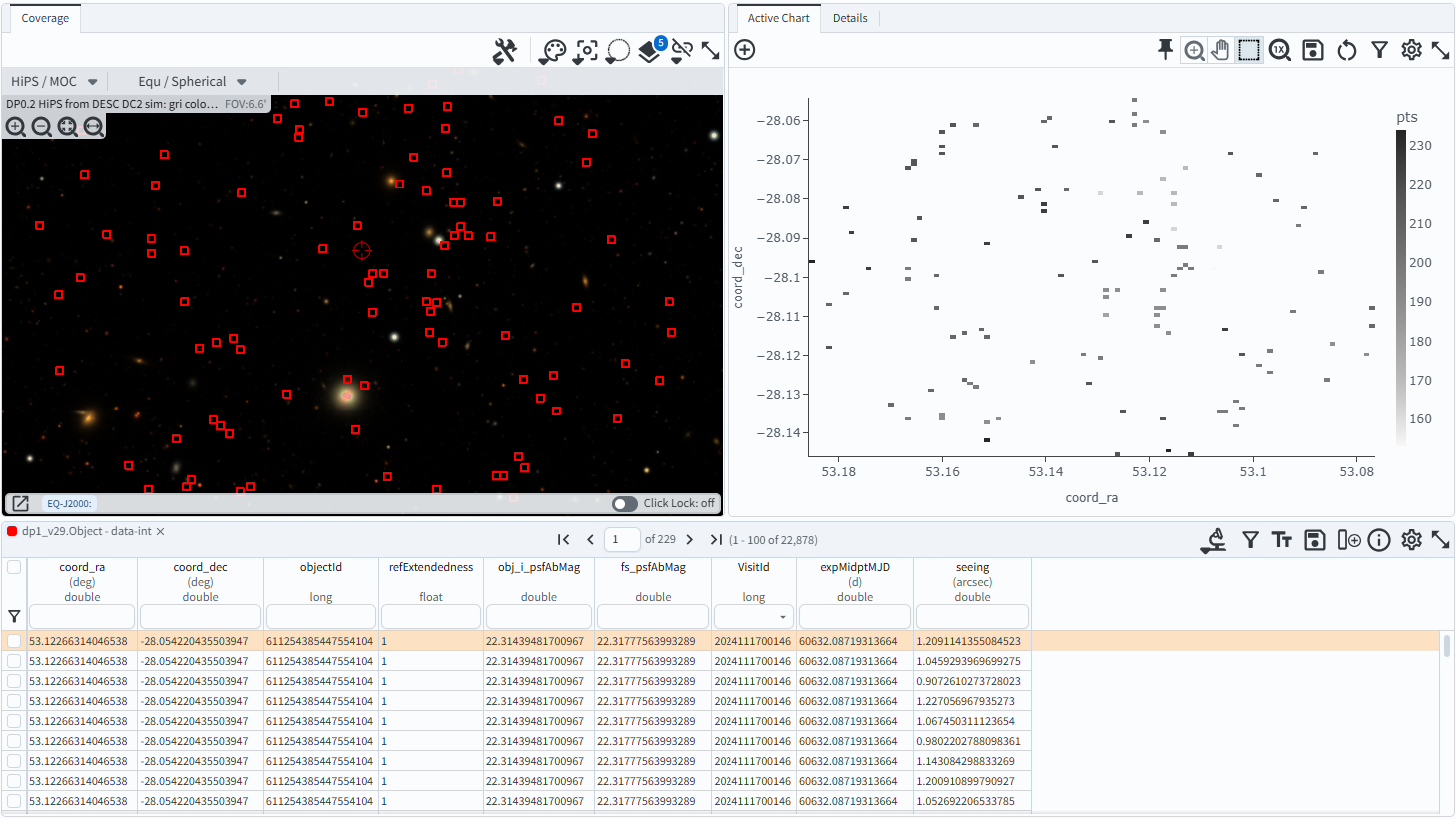103.4. Join tables with ADQL#
For the Portal Aspect of the Rubin Science Platform at data.lsst.cloud.
Data Release: DP1
Last verified to run: 2025-06-28
Learning objective: Join multiple tables to retrieve combined results with ADQL.
LSST data products: Source, Visit, CcdVisit, and Object tables
Credit: Originally developed by the Rubin Community Science Team. Please consider acknowledging them if this tutorial is used for the preparation of journal articles, software releases, or other tutorials.
Get Support: Everyone is encouraged to ask questions or raise issues in the Support Category of the Rubin Community Forum. Rubin staff will respond to all questions posted there.
Warning! Not all tables can be joined. Two tables must have a column in common in order to be joined.
1. Go to the DP1 Catalogs ADQL interface. Navigate to the Portal’s DP1 Catalogs tab and switch to the ADQL interface by clicking “Edit ADQL”.
2. The ADQL components of a JOIN…ON statment. The generic example below illustrates a common join scenario. Four columns (“ra”, “dec”, “colA”, and “colB”) are selected from “table1”, for objects where their coordinates are within 0.05 degrees of RA=62 deg, Dec=-37 deg. The results from “table1” are joined with “table2” on their matching column, “colID”. Two columns are selected from “table2” (“colX” and “colY”).
**This is a generic example - it cannot be executed.**
SELECT tab1.ra, tab1.dec, tab1.colA, tab1.colB, tab2.colX, tab2.colY
FROM table1 AS tab1
JOIN table2 AS tab2
ON tab1.colID = tab2.colID
WHERE CONTAINS(POINT('ICRS', tab1.ra, tab1.dec),
CIRCLE('ICRS', 62.0, -37, 0.05)) = 1
3. Execute a two-table join.
The Source table (detections in individual processed visit images) can be joined with the
CcdVisit table (metadata about individual visits) using a shared column, named Visit
in the Source table and VisitId in the CcdVisit table,
which identifies an LSST visit.
Constraints can be applied on columns from either or both tables.
Spatial constraints are applied to the FROM table, not the JOIN table.
SELECT src.coord_ra, src.coord_dec, src.sourceId, src.band,
scisql_nanojanskyToAbMag(src.psfFlux) AS psfAbMag,
src.Visit, cv.VisitId,
cv.expMidptMJD, cv.seeing
FROM dp1.Source AS src
JOIN dp1.CcdVisit AS cv
ON src.Visit = cv.VisitId
WHERE CONTAINS(POINT('ICRS', src.coord_ra, src.coord_dec),
CIRCLE('ICRS', 53.13, -28.10, 0.05)) = 1
AND cv.expMidptMJD > 60631 AND cv.expMidptMJD < 60637
AND src.band = 'i'
4. Review the two-table join results.
Notice that this join is not one-to-one: there are multiple individual sources returned that are matched to the same visit.
In other words, there are multiple rows from the Source table joined with a given row from the CcdVisit table.
If multiple tabs are present above the upper left panel in the default Results tab layout, click the “Coverage” tab to display the coverage chart.

Figure 1: The Portal Results tab with a default layout for the data returned from the two-table join query.#
5. Execute a three-table join.
The Object table (photometry in the deepCoadd images) can be joined with the
ForcedSource table (photometry in individual processed visit images) using their shared objectId column.
The ForcedSource table can be joined with the CcdVisit table (metadata about individual visits) using a shared column, named Visit
in the ForcedSource table and VisitId in the CcdVisit table,
which identifies an LSST visit.
SELECT obj.coord_ra, obj.coord_dec, obj.objectId, obj.refExtendedness,
scisql_nanojanskyToAbMag(obj.i_psfFlux) AS obj_i_psfAbMag,
scisql_nanojanskyToAbMag(fs.psfFlux) AS fs_psfAbMag,
cv.VisitId, cv.expMidptMJD, cv.seeing
FROM dp1.Object AS obj
JOIN dp1.ForcedSource AS fs
ON obj.objectId = fs.objectId
JOIN dp1.CcdVisit AS cv
ON fs.Visit = cv.VisitId
WHERE CONTAINS(POINT('ICRS', obj.coord_ra, obj.coord_dec),
CIRCLE('ICRS', 53.13, -28.10, 0.05)) = 1
AND obj.refExtendedness = 1
AND obj.i_psfFlux > 3600
AND cv.expMidptMJD > 60631 AND cv.expMidptMJD < 60637
AND fs.band = 'i'
6. Review the three-table join results.
The join of Object to ForcedSource is one-to-many, and the join of ForcedSource to CcdVisit is many-to-one.
To view the coverage chart, click the “Coverage” tab at the top of the upper left panel.

Figure 2: The Portal Results tab with the layout displaying the activated coverage chart for the data returned from the three-table join query.#